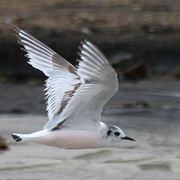Little Gull
The Washington representatives of this family can be split into two groups, or subfamilies. The adaptable gulls are the most familiar. Sociable in all seasons, they are mainly coastal, but a number of species also nest inland. Many—but not all—are found around people. Gulls have highly variable foraging techniques and diets. Terns forage in flight, swooping to catch fish or insects. They dive headfirst into the water for fish. Although they are likely to be near water, they spend less time swimming than gulls.
General Description
The smallest of the gulls, the Little Gull has a short, narrow bill, red legs, and a short tail. In breeding plumage, the adult has a dark hood with a black eye and bill. Non-breeding plumage is similar, but the head is white, smudged with black, with a black ear-spot behind the eye. The body coloration is typical of gull plumage from above, but both breeding and non-breeding adults have dark underwings with pale wingtips, which are distinctive in flight. Juveniles are mottled dark brown, mixed with varying degrees of adult plumage characteristics. In flight, juveniles have a dark 'W' across the underwing.
Habitat
Breeding habitat is mostly inland around low-lying marshy areas near lakes. Winter habitat is along coasts in protected shallow estuaries, mudflats, and beaches, and nearby fresh water lakes.
Behavior
Lone Little Gulls are often found amidst flocks of Bonaparte's Gulls and terns. They often forage in flight, flying slowly low over the water and dropping down to pluck items from the surface. They also land on the water and feed from a swimming or wading position.
Diet
In the summer, small insects make up the majority of the diet. Small crustaceans, mollusks, small fish, and other aquatic creatures round out the diet the rest of the year.
Nesting
A primarily Eurasian species, where they breed in colonies, Little Gulls in North America usually nest in small colonies or isolated pairs. Nests are on the ground, near water. Both sexes help build a nest of grass, weeds, and leaves with a shallow depression in the middle. Both help incubate the 2 to 3 eggs for about 3½ weeks. Both parents help tend the young, which leave the nest shortly after hatching, but stay close by. Three to four weeks later, they fledge.
Migration Status
Migratory movements in North America are not well known.
Conservation Status
How the Little Gull ended up in North America is unknown. Some argue that it has always occurred here in small numbers. Others claim that it colonized by way of the Bering Sea. A third theory is that Little Gulls came across the Atlantic. The first known record of a Little Gull in North America is from 1820, and the first nesting record is from 1962. As of 1999, there had been only 67 confirmed or probable nesting reports documented in North America. Most of these were in wetlands in the Great Lakes and St. Lawrence River regions. The first appearance in Washington was in the fall of 1974. It has now been recorded up and down the West Coast throughout the year. The nesting population in North America may not be self-sustaining, and is supplemented by an influx of European vagrants.
When and Where to Find in Washington
In Washington, sightings of the Little Gull are rare and occur primarily in the fall (September-November) in coastal and western Washington regions in aquatic habitats. Look for them in mixed flocks with Bonaparte's Gulls. American Lake near Fort Lewis (Pierce County) and Point No Point (Kitsap County) are traditional sites for this species.
 Abundance
Abundance
| Ecoregion | Jan | Feb | Mar | Apr | May | Jun | Jul | Aug | Sep | Oct | Nov | Dec |
|---|---|---|---|---|---|---|---|---|---|---|---|---|
| Oceanic | ||||||||||||
| Pacific Northwest Coast | ||||||||||||
| Puget Trough | R | R | R | R | R | R | ||||||
| North Cascades | ||||||||||||
| West Cascades | ||||||||||||
| East Cascades | ||||||||||||
| Okanogan | ||||||||||||
| Canadian Rockies | ||||||||||||
| Blue Mountains | ||||||||||||
| Columbia Plateau |
Washington Range Map

Family Members
 Laughing GullLarus atricilla
Laughing GullLarus atricilla Franklin's GullLarus pipixcan
Franklin's GullLarus pipixcan Little GullLarus minutus
Little GullLarus minutus Black-headed GullLarus ridibundus
Black-headed GullLarus ridibundus Bonaparte's GullLarus philadelphia
Bonaparte's GullLarus philadelphia Heermann's GullLarus heermanni
Heermann's GullLarus heermanni Black-tailed GullLarus crassirostris
Black-tailed GullLarus crassirostris Short-billed GullLarus canus
Short-billed GullLarus canus Ring-billed GullLarus delawarensis
Ring-billed GullLarus delawarensis California GullLarus californicus
California GullLarus californicus Herring GullLarus argentatus
Herring GullLarus argentatus Thayer's GullLarus thayeri
Thayer's GullLarus thayeri Iceland GullLarus glaucoides
Iceland GullLarus glaucoides Lesser Black-backed GullLarus fuscus
Lesser Black-backed GullLarus fuscus Slaty-backed GullLarus schistisagus
Slaty-backed GullLarus schistisagus Western GullLarus occidentalis
Western GullLarus occidentalis Glaucous-winged GullLarus glaucescens
Glaucous-winged GullLarus glaucescens Glaucous GullLarus hyperboreus
Glaucous GullLarus hyperboreus Great Black-backed GullLarus marinus
Great Black-backed GullLarus marinus Sabine's GullXema sabini
Sabine's GullXema sabini Black-legged KittiwakeRissa tridactyla
Black-legged KittiwakeRissa tridactyla Red-legged KittiwakeRissa brevirostris
Red-legged KittiwakeRissa brevirostris Ross's GullRhodostethia rosea
Ross's GullRhodostethia rosea Ivory GullPagophila eburnea
Ivory GullPagophila eburnea Least TernSternula antillarum
Least TernSternula antillarum Caspian TernHydroprogne caspia
Caspian TernHydroprogne caspia Black TernChlidonias niger
Black TernChlidonias niger Common TernSterna hirundo
Common TernSterna hirundo Arctic TernSterna paradisaea
Arctic TernSterna paradisaea Forster's TernSterna forsteri
Forster's TernSterna forsteri Elegant TernThalasseus elegans
Elegant TernThalasseus elegans

